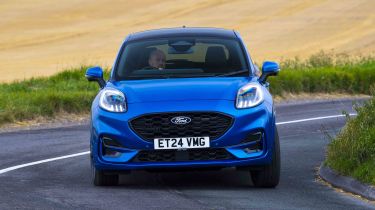Ford Puma - Engines, performance and drive
The EcoBoost engines are punchy, while the Ford Puma is the most fun small SUV to drive

Things have been kept very simple for the updated Ford Puma line-up, to the point of making the choice a little too limited for some customers. The long-lived 1.0-litre EcoBoost three-cylinder turbocharged petrol unit is available here in three levels of tune. The 123bhp version kicks off the range, above which sits a 153bhp variant of the same unit.
The sporty ST model isn’t quite as hot as it once was, and now exclusively uses the 168bhp version of the 1.0-litre EcoBoost engine and is automatic only. That’s quite a far cry from the previous 197bhp 1.5-litre turbo and manual gearbox combination, which significantly increased the ante in terms of driver involvement and excitement.
The next model down from the ST, the 153bhp EcoBoost, is also auto-only, while the 123bhp model is available with an auto or, for £1,800 less, a six-speed manual transmission. Every model is front-wheel drive and features fuel-saving 48-volt mild-hybrid technology.
Ford has earned a reputation for producing a range of everyday cars that appeal to the keen driver after decades of sharp-handling hatchbacks. The Puma lives up to that, and when it comes to handling, it still has the beating of its competition when it comes to fun. However, the powertrains are not without their faults, which mainly focus on the shortcomings of Ford’s seven-speed automatic gearbox.
|
Model |
Power |
0-62mph |
Top speed |
|
Puma 1.0 EcoBoost mHEV 125 Titanium |
123bhp |
9.8 |
119mph |
|
Puma 1.0 EcoBoost mHEV 155 Titanium auto |
153bhp |
8.7 |
124mph |
|
Puma 1.0 EcoBoost mHEV 125 ST auto |
168bhp |
7.4 |
130mph |
What is the Ford Puma like to drive?
In town
Many of the Puma’s controls, from the steering to the clutch, are light and precise, so it feels very easy to drive around town. The turning circle is excellent, and the supermini-sized dimensions make the Ford simple to place on the road and park.
Used - available now
The automatic gearbox is smooth at low speeds, although the three-cylinder engines do produce a noticeable amount of vibration both at idle and under acceleration.
On A- and B-roads
The Puma is still by far the best-handling car in the segment. It’s agile, grippy and sweetly balanced, with sharp, positive steering to make even the most mundane journeys enjoyable.
While the ride is on the firm side of the class, it’s not crashy. The positive body control helps negotiate some bumps, too, because over uneven and adversely cambered roads, the body doesn’t get thrown around as much as it does in some other small SUVs.
However, we’d avoid going too high up the Puma range if you can, because ride comfort on ST-Line X models – equipped with 19-inch wheels and uprated suspension – is certainly treading a fine line between a sporty feeling and outright bumpiness.
People who like a car that responds quickly to inputs would do well to avoid the automatic gearbox. It’s very slow and unresponsive when driving keenly, which means it’s frequently bogged down when entering a corner. Sport mode helps because it holds a lower ratio, but that still means you’re at least one gear too high for a corner, rather than two or three when in normal mode.
This situation is compounded by the fact that there’s no manual override available with the automatic transmission, which completely kills the fun. This would be fine if Ford offered each version with a manual gearbox, but the two most powerful engines – including the ST – are only available with the auto.
On the motorway
The EcoBoost units, which can be slightly thrummy at lower speeds, settle down into a quiet cruise. Decent torque figures mean that they generally feel fairly strong when accelerating up to 70mph, too. The base model’s 0-62mph time of 9.8 seconds will be more than enough for most buyers.
0-62mph acceleration and top speed
All versions of the Ford Puma can accelerate from 0-62mph in less than 10 seconds, with the slowest model being the 123bhp manual model, which has a time of 9.8 seconds. Adding the seven-speed auto sees a couple of tenths shaved off for a time of 9.6 seconds.
The auto-only 153bhp version of the EcoBoost engine has an official 0-62mph time of 8.7 seconds, while the auto-equipped Puma ST can accelerate from 0-62mph in 7.4 seconds. That’s with the overboost function activated, which automatically cuts in when using full throttle to give the maximum 168bhp - at all other times, maximum output is restricted to 158bhp to help save wear and tear on the car’s running gear.
The Puma uses a mild-hybrid system to help boost performance while also making it more efficient, but the only downside to the mild-hybrid system is that to fill the small battery pack with energy, the Puma features a very minor amount of brake energy regeneration. It’s set at a constant, unchangeable level that’s just about detectable when you lift off the throttle and feel the car slow more quickly than it otherwise would, and takes a little getting used to.












